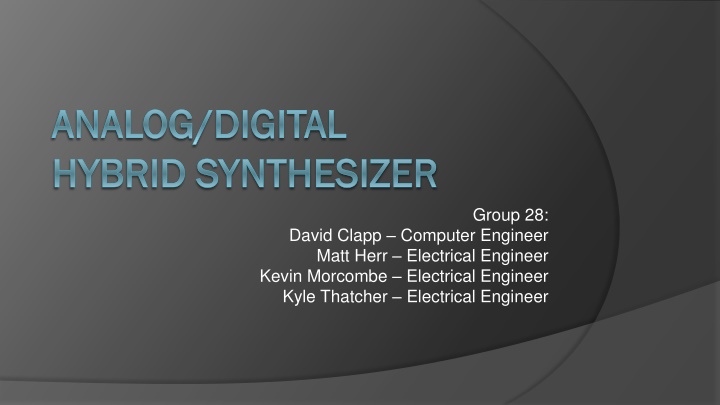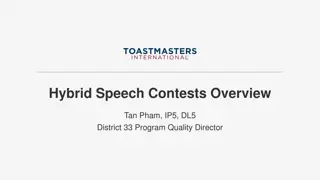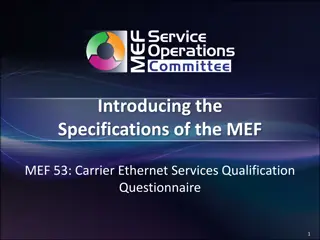Hybrid Synthesizer Project Details and Specifications
Group 28 led by David Clapp, consisting of computer and electrical engineers, is working on a hybrid synthesizer project to address the lack of natural-sounding analog synthesizers in the industry. The project aims to create an electronic musical instrument combining analog tone generation with digital control features. Key project goals include onboard oscillators, various effects, microcontroller functionality, presets, standalone device control, and MIDI technology integration. Detailed final specifications involve MCU components, VCO pitch accuracy, signal capability, filter range, and VCA distortion. The project also includes a control system design selection with specific goals and microcontroller options such as Microchip PIC24FJ64GB406, Arduino Mega 2560, and Raspberry Pi 3 Model B based on architecture, memory, price, and difficulty level.
Download Presentation

Please find below an Image/Link to download the presentation.
The content on the website is provided AS IS for your information and personal use only. It may not be sold, licensed, or shared on other websites without obtaining consent from the author.If you encounter any issues during the download, it is possible that the publisher has removed the file from their server.
You are allowed to download the files provided on this website for personal or commercial use, subject to the condition that they are used lawfully. All files are the property of their respective owners.
The content on the website is provided AS IS for your information and personal use only. It may not be sold, licensed, or shared on other websites without obtaining consent from the author.
E N D
Presentation Transcript
ANALOG/DIGITAL ANALOG/DIGITAL HYBRID SYNTHESIZER HYBRID SYNTHESIZER Group 28: David Clapp Computer Engineer Matt Herr Electrical Engineer Kevin Morcombe Electrical Engineer Kyle Thatcher Electrical Engineer
Motivation Lack of Analog Synthesizers available as Full Digital, or Plug-in type synthesizers dominate the industry. Want to produce more natural sounds while still enveloping the control that comes with a digital synthesizer. Most analog synthesizers are elaborate and expensive.
Project Goals Create an electronic musical instrument which produces sounds through analog means. Tone generation through on board Oscillators Various effects typically found in modern synths Microcontroller Functionality Presets Complete Standalone device control Control External devices through MIDI technology Have other devices control this device through MIDI
Final Specifications Component MCU Parameter User Delay (Lag) Specification < 250ms MCU User Accessibility MIDI 1.01 compliant MCU Musical Range > 18 keys, octave switch VCO Pitch Accuracy 6 octave/ 20Hz 21kHz VCO/LFO Signal Capability Sine/Triangle/Square VCF Filter Range 20Hz 21kHz VCA Distortion < .01%
Control Systems Control Systems
Control Systems Design Selection Goals: 1. All systems have no greater than 250ms delay 2. 90% code reliability 3. Code scalable and modular
Control Systems -Microcontroller Microchip PIC24FJ64GB406 Arduino Mega 2560 Raspberry Pi 3 Model B Architecture 8 Bit 64 bit 16 Bit Serial UART, I2C, SPI UART, I2C, SPI UART, I2C, SPI Memory 256KB 1GB 64KB Price 45.95 35 4.62 Difficulty (1-10) 5 3 9
Control Systems - Technologies Programming Environment: Operating System: Raspbian Serial Communication Interfaces: UART serial bus Universal Asynchronous Receiver/Transmitter Used to transmit MIDI output signal Industry standard serial bus for MIDI I C serial bus Inter-Integrated Communication Used to: Expand the number of available I/O pins Control digital potentiometers Language: C MIDI testing: MIDIOX on Windows 7
Control Systems Human Interface Devices Tactile Switches Indirect control of VCOs Rotary Encoders Indirect control of DigiPots
Hardware Hardware
VCO and Signal Mixer VCO Goals and Objectives 1. Produce several waveforms sine, square, triangle, sawooth 2. Operate on +/- 12VDC input 3. Produce waveforms on audible frequencies 20 Hz 20 kHz Signal Mixer Goals and Objectives 1. Allow operation of two separate VCOs 2. Tone stacking 3. Variable frequency mix
LFO - Design Selection Goals: 1. 2. 3. Provide modulation waveforms for VCO output (produce vibrato) Provide variable frequencies from 2 to 25 Hz Integrate seamlessly with project Design Range (2-25Hz) .5 40 Hz Triangle/ Ramp Sine Square Hi-Lo Switch Size (PCB) TL084 CEM3340 2 30 Hz XR2206 2 30 Hz
Voltage Controlled Filter Goals Create a viable effect utilizing a Low Pass Filter with adjustable Quality factor and Cutoff range. Capable of being controlled by the LFO Cutoff Sweep Controllable Via the user directly using rotary encoder.
Attack Release Envelope Goals: Allow the user to alter their attack and release times to fit their desired needs. Design Criteria: Focus on Simplicity and functionality Time of envelope based on qualitative response.
VCA Voltage Controlled Amplifier
VCA - Design Selection Goals: Control/Amplify the final audio signal from the VCF/Envelope Minimize noise/distortion in signal Integrate seamlessly into project 1. 2. 3. Design Linear Response Exponential Response Low Noise Low Size Distortion LM13700 <.01% V2181 <.01% THAT2181 <.01%
Power Supply Goals and Objectives 1. Eliminate need for batteries cost waste 2. Input power from wall; 12V RMS, 60 Hz 3. Store voltage in electrolytic capacitors 4. Prevent unwanted current paths 5. Produce clean +/- 12 VDC output
Administrative Content Administrative Content
Work Distribution Member Human Interfac e Power VCO VCF VCA AR LFO MCU David Kevin Kyle Matt Key: Primary Green Secondary Blue
Budget Budget Vendor Price Quantity Total Cost Description Mouser $ 35.00 1 $ 35.00 Microcontroller Elecrow $ 50.00 1-5 $50 - $250 Custom PCB Mouser $ 18.76 1 $ 18.76 VCO Mouser $ 24.32 1 $ 100.00 LFO Mouser $ 11.65 1 $ 11.65 VCF Mouser $ 22.51 1 $ 22.51 VCA Mouser $ 6.31 1 $ 6.31 AR envelope generator Undertermined $ 60.00 1 $ 60.00 Housing Unit $ 120.00 1 $ 120.00 Shipping $ 100.00 1 $ 100.00 Misc Unforseen Costs $ 574.53 Total
Progress Research PCB Design Enclosure/Wiring Prototyping Overall 0 10 20 30 40 50 60 70 80 90 100
Future Challenges Final PCB Design Enclosure/Wiring Code Stability Calibration Issues























